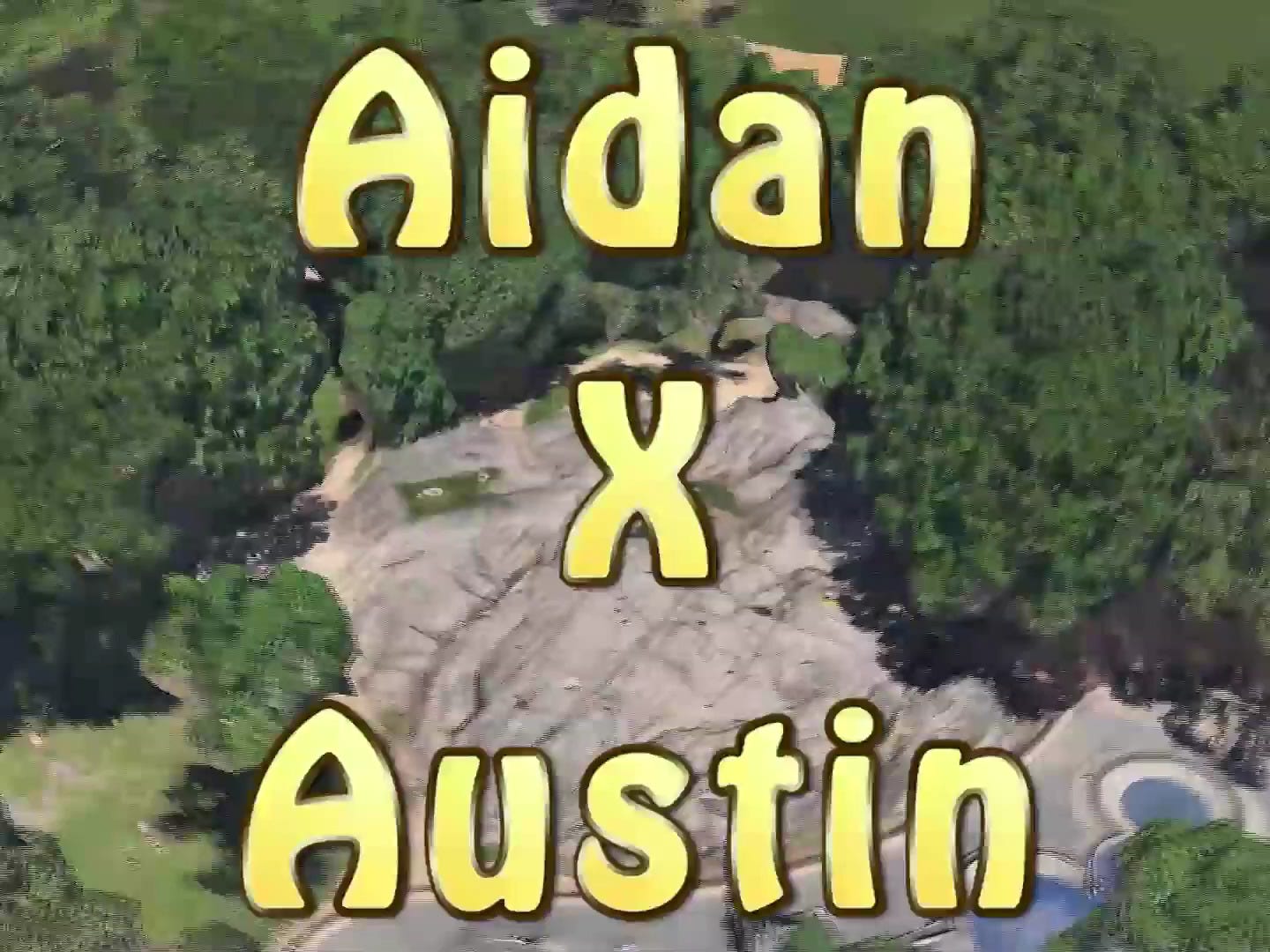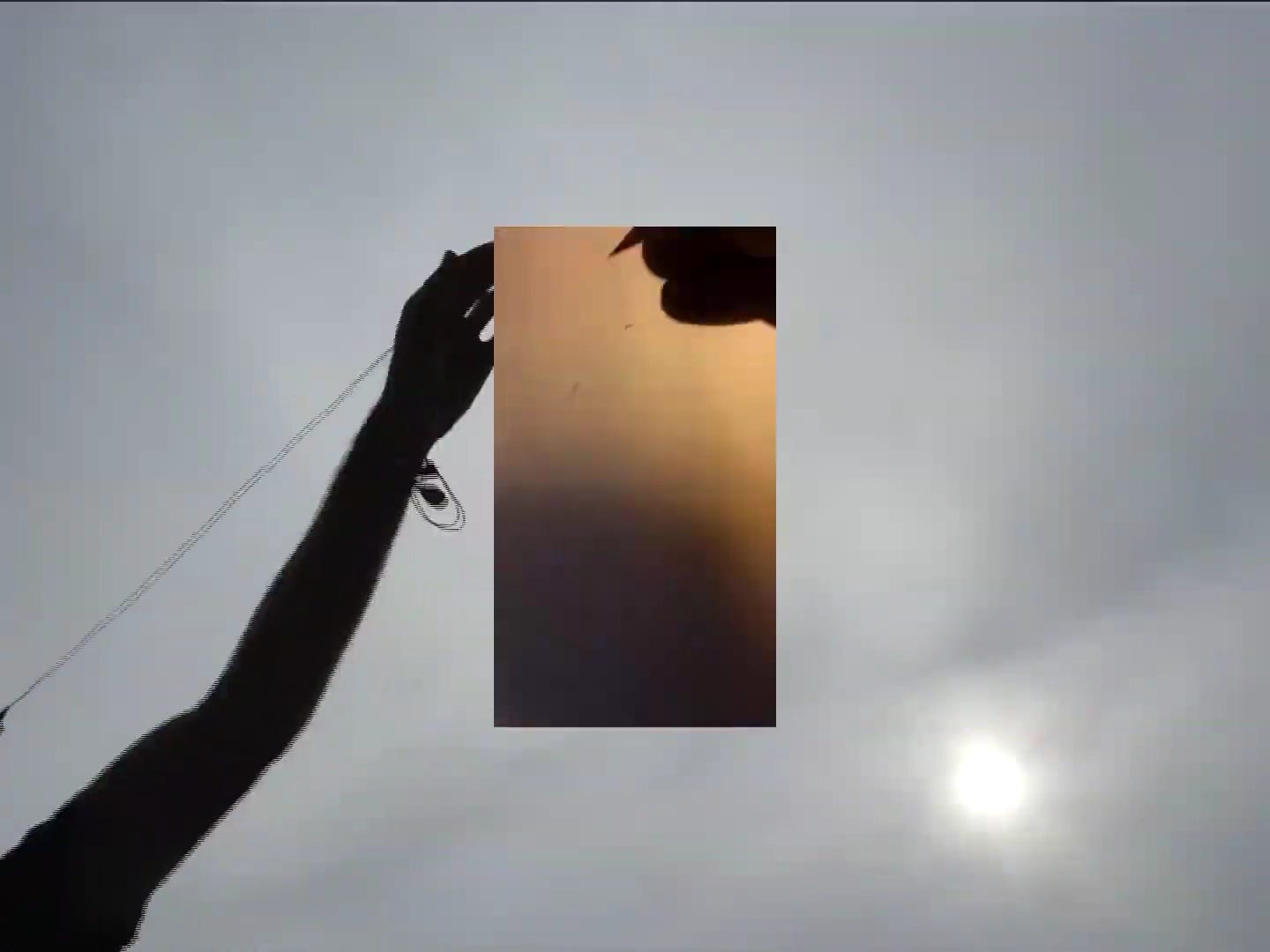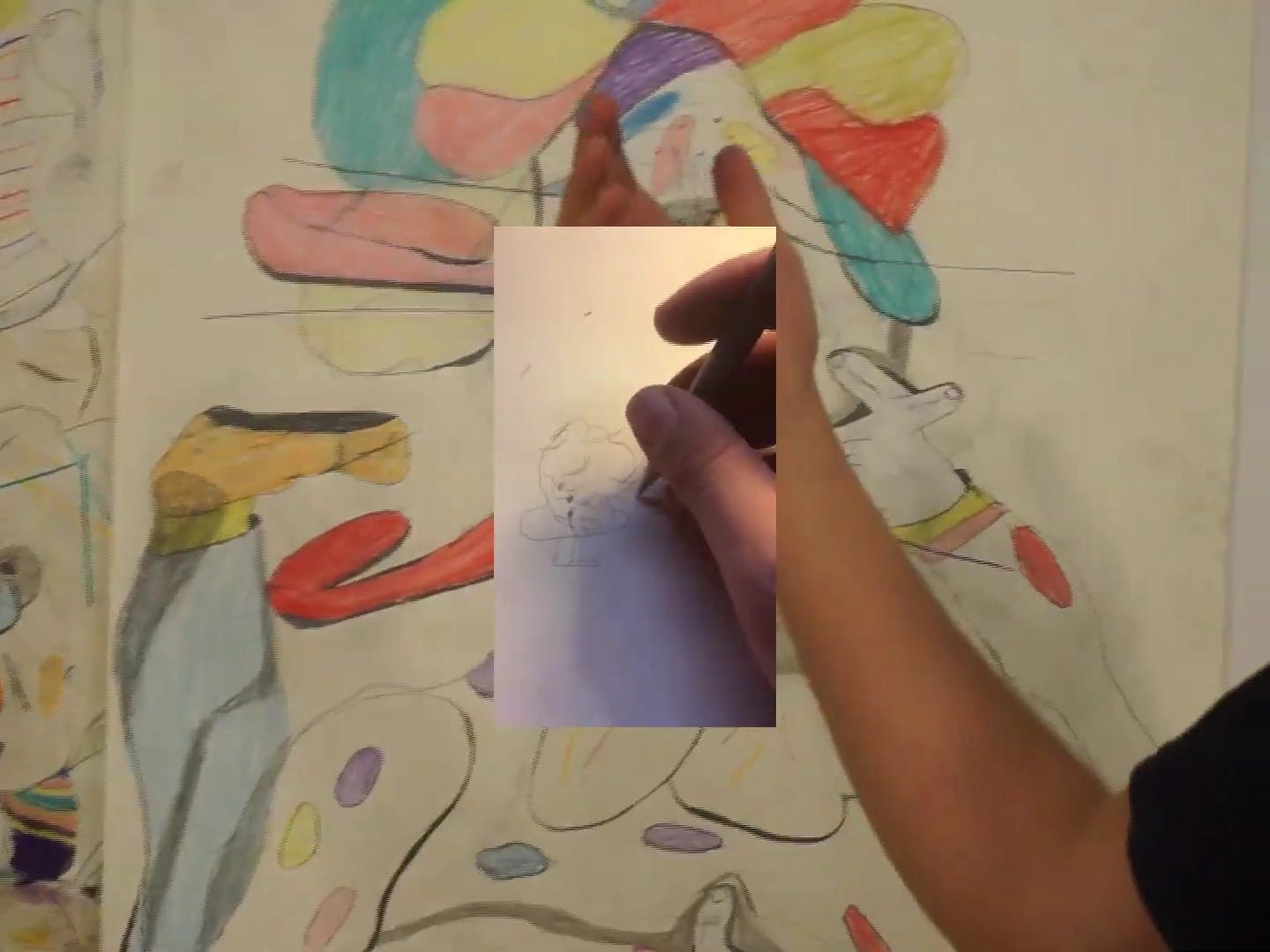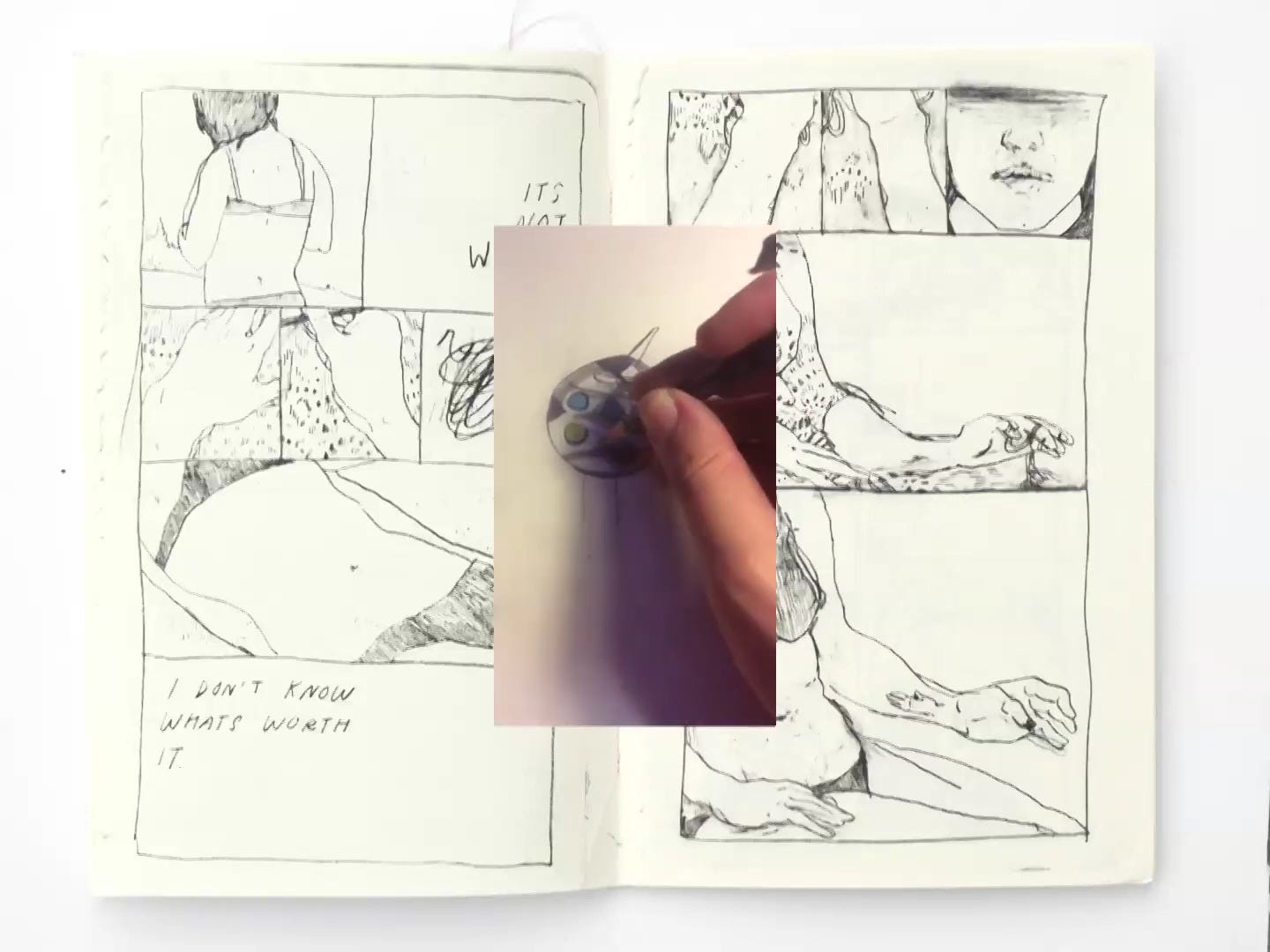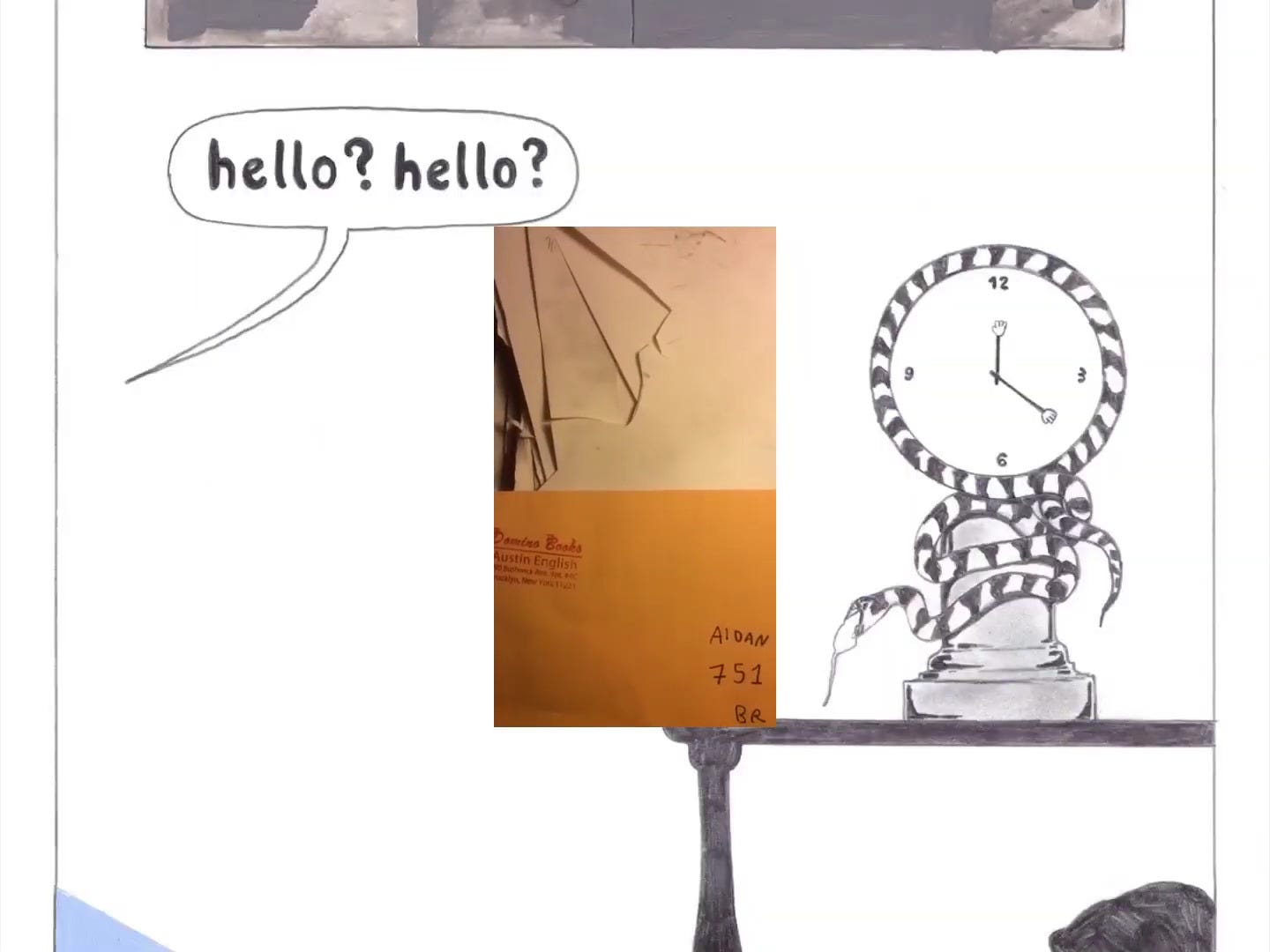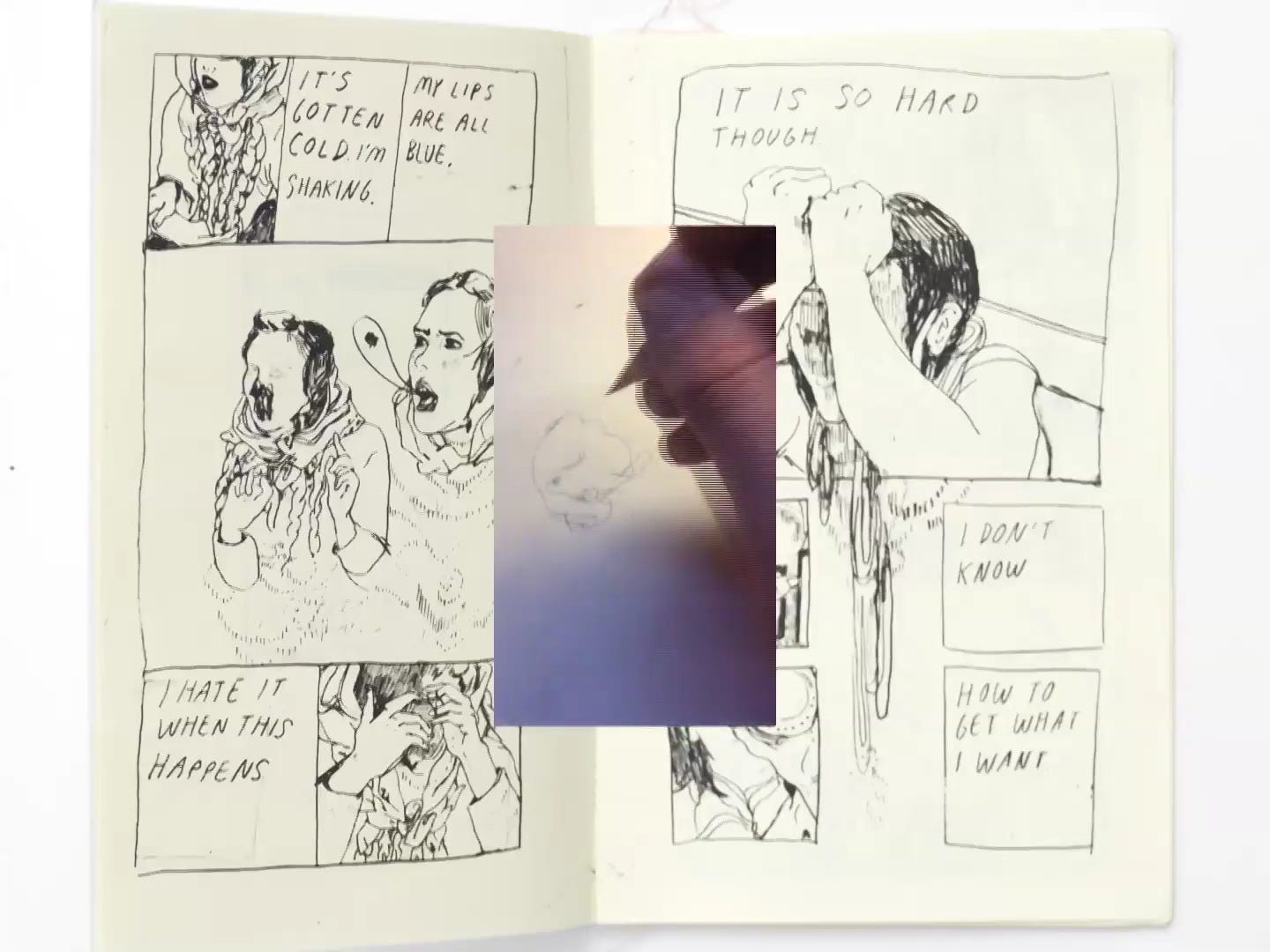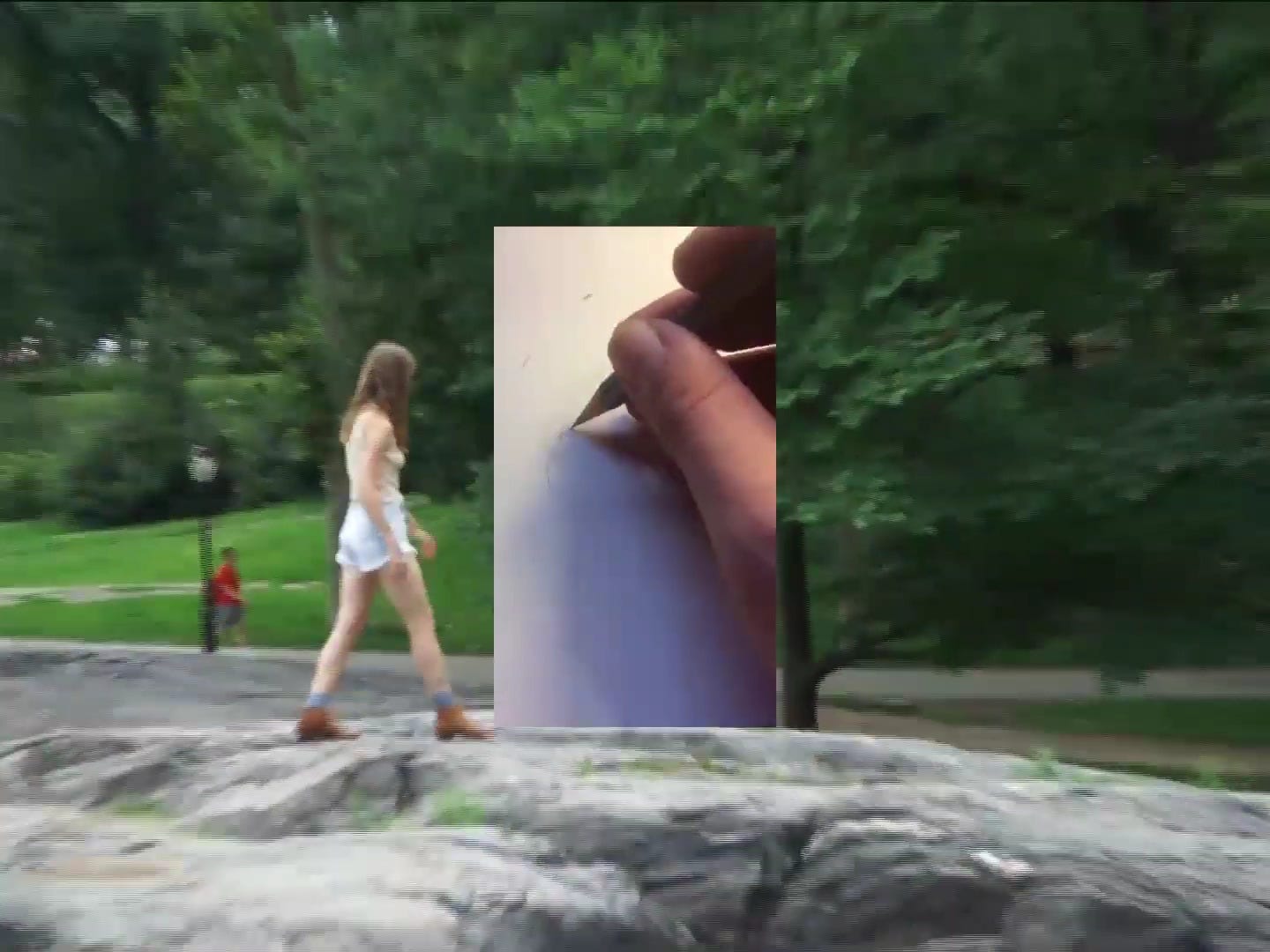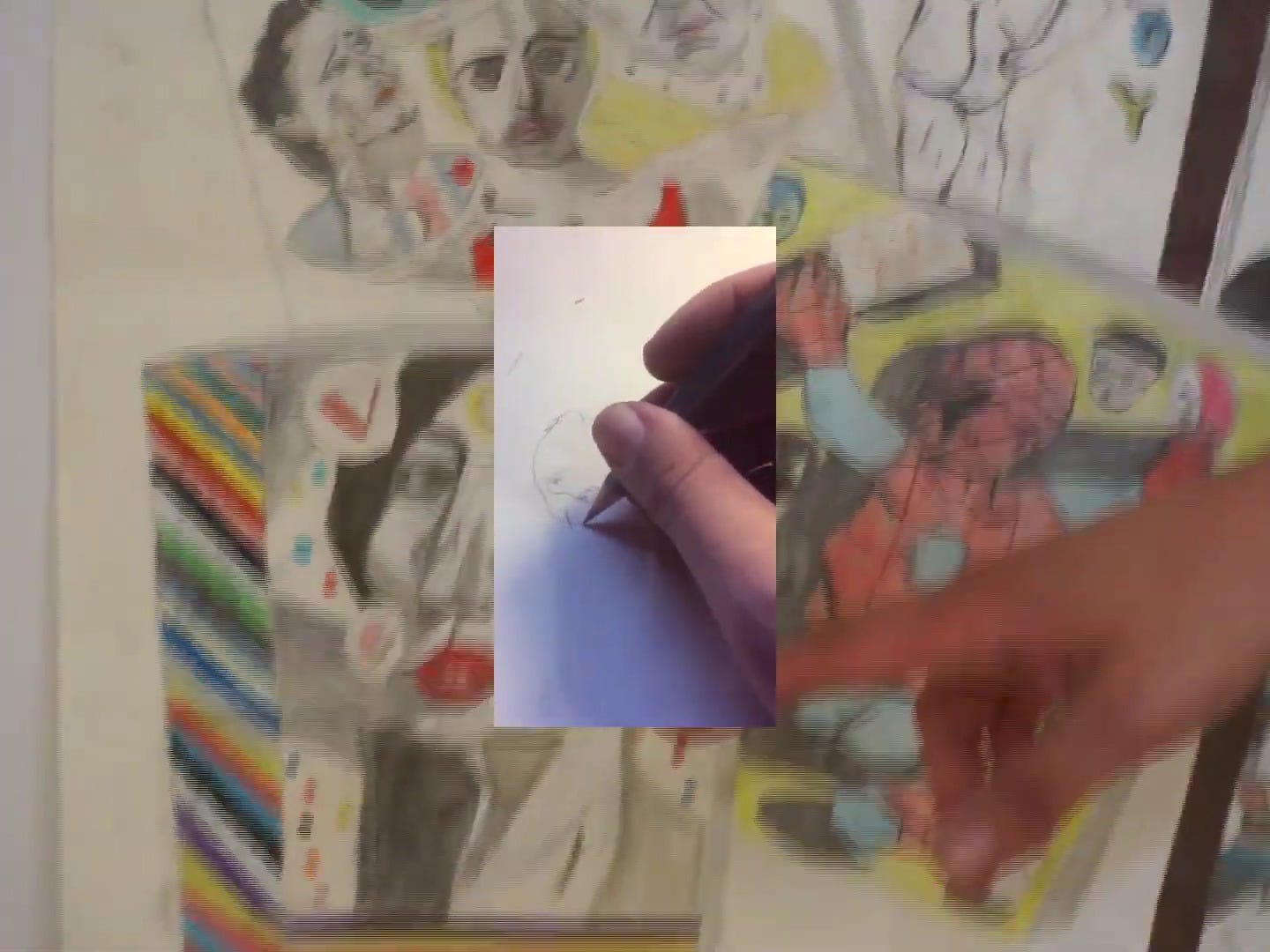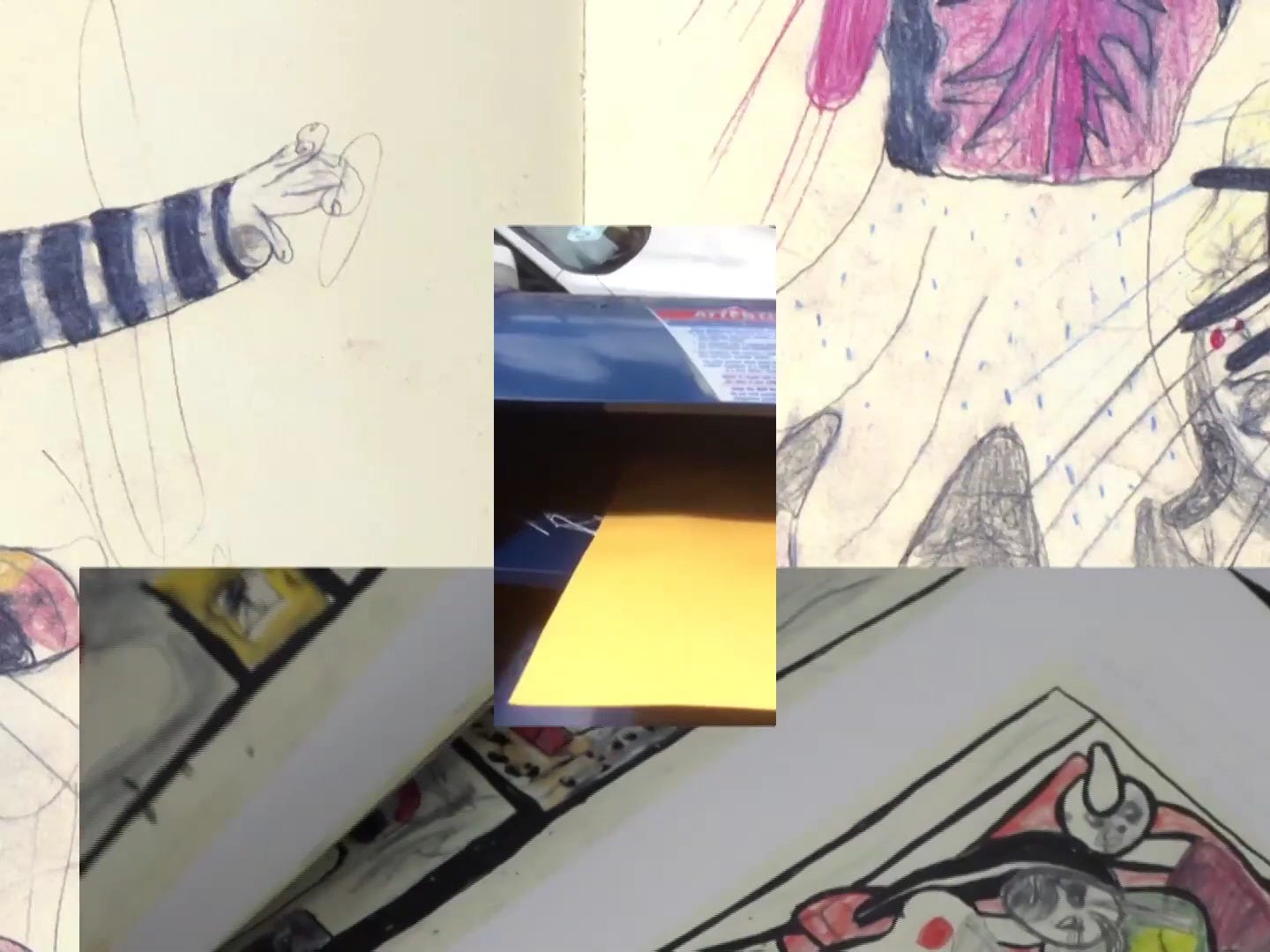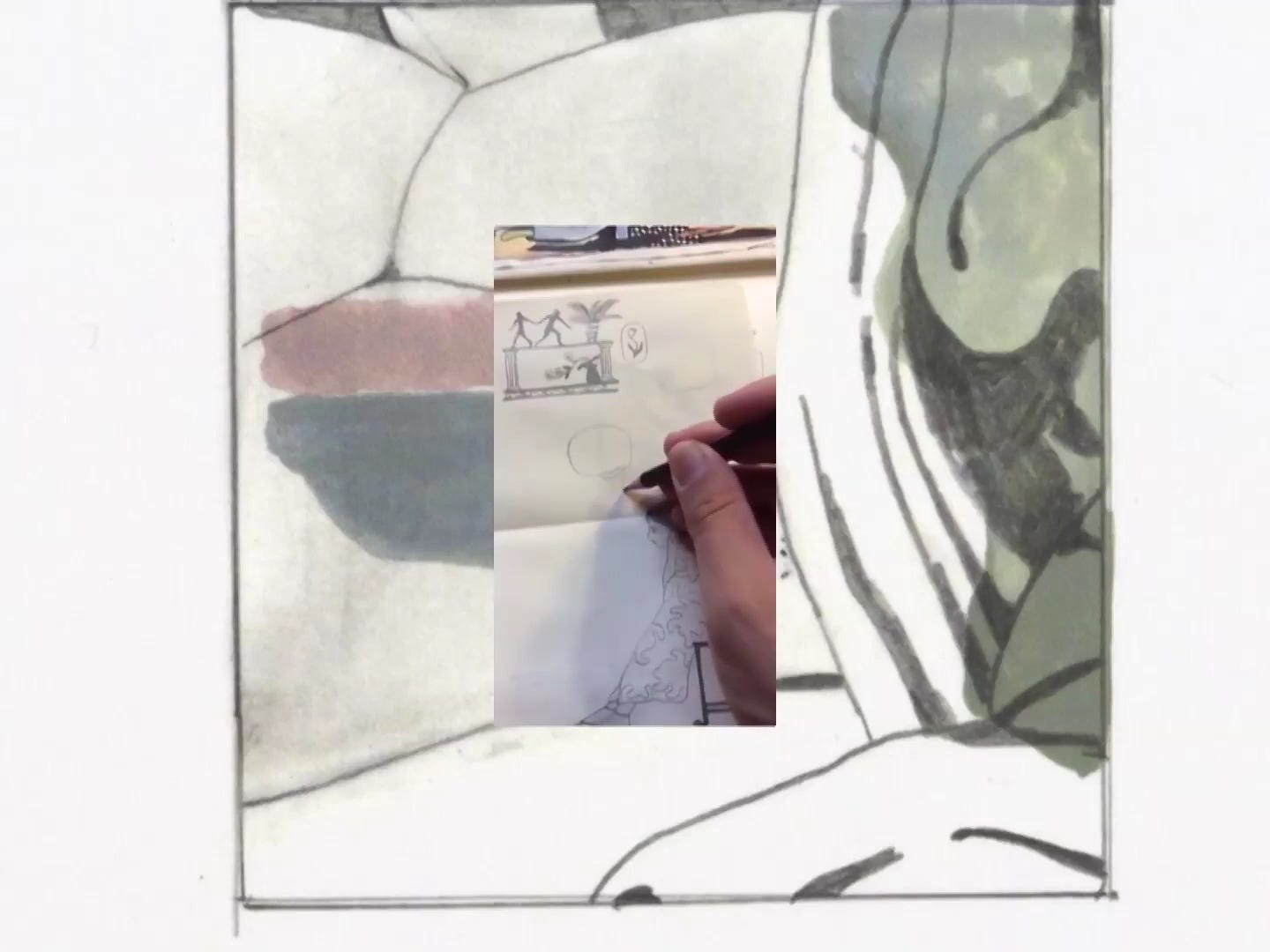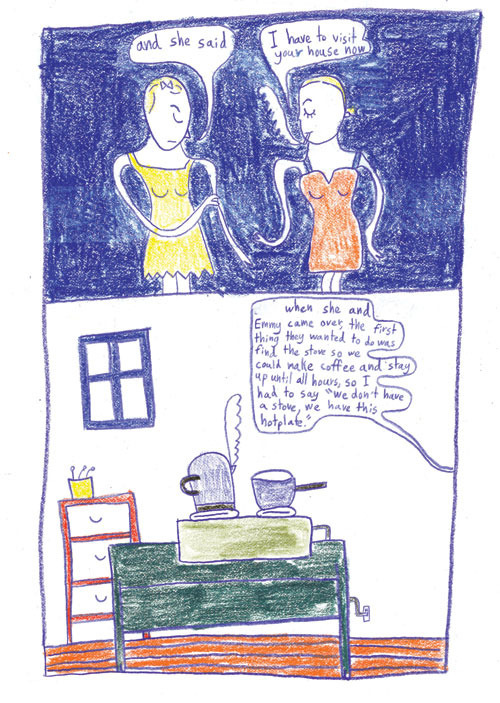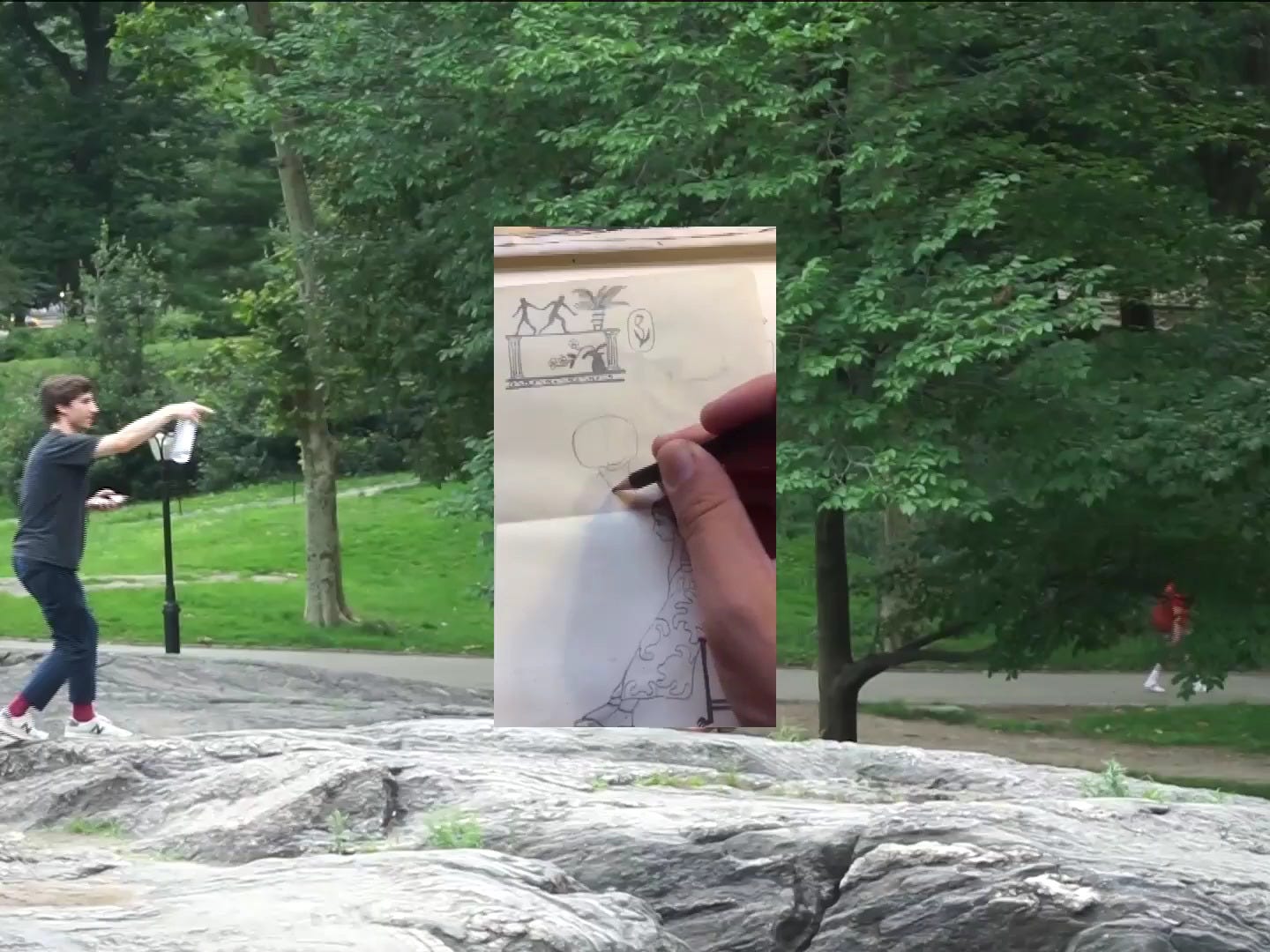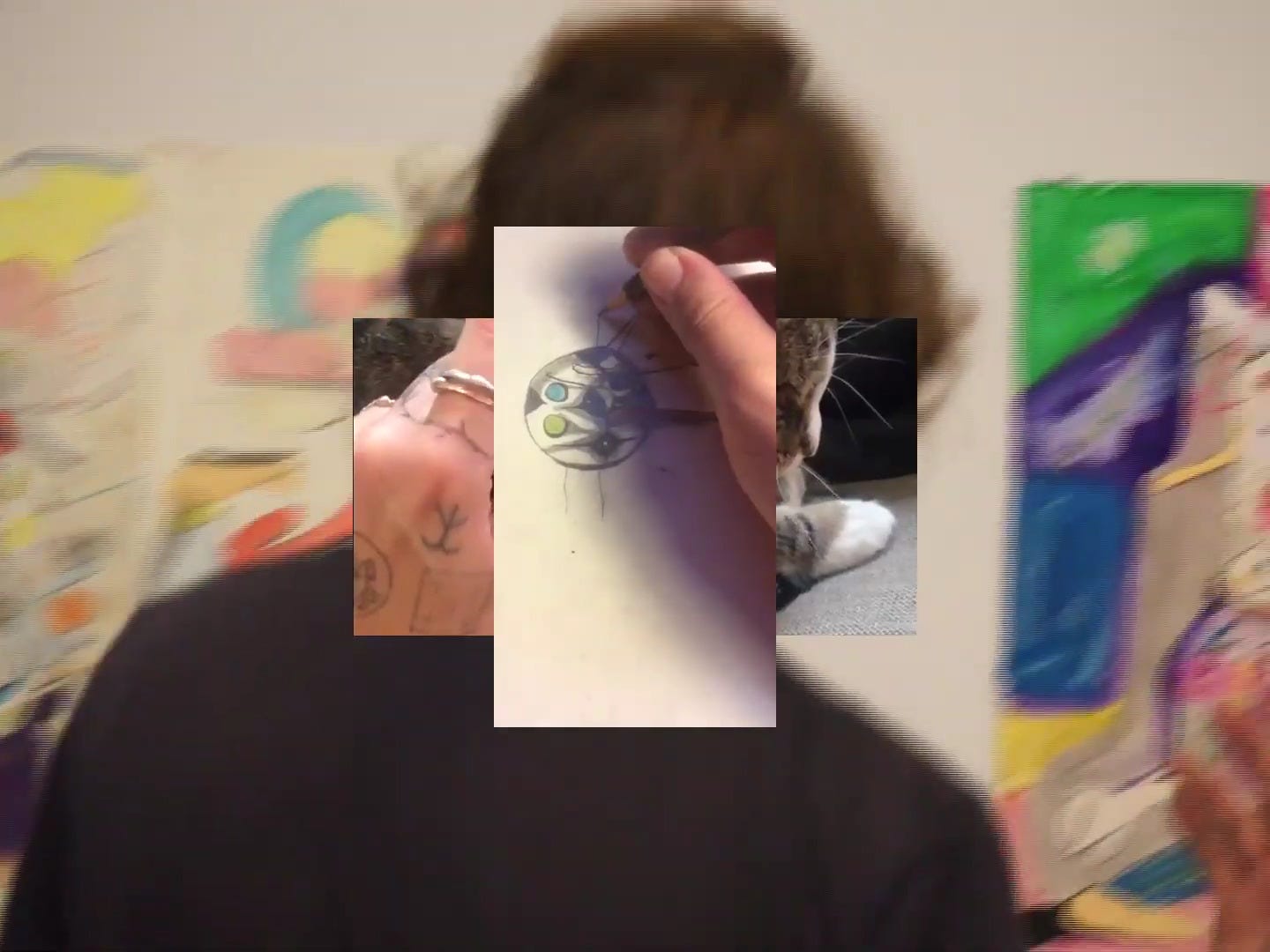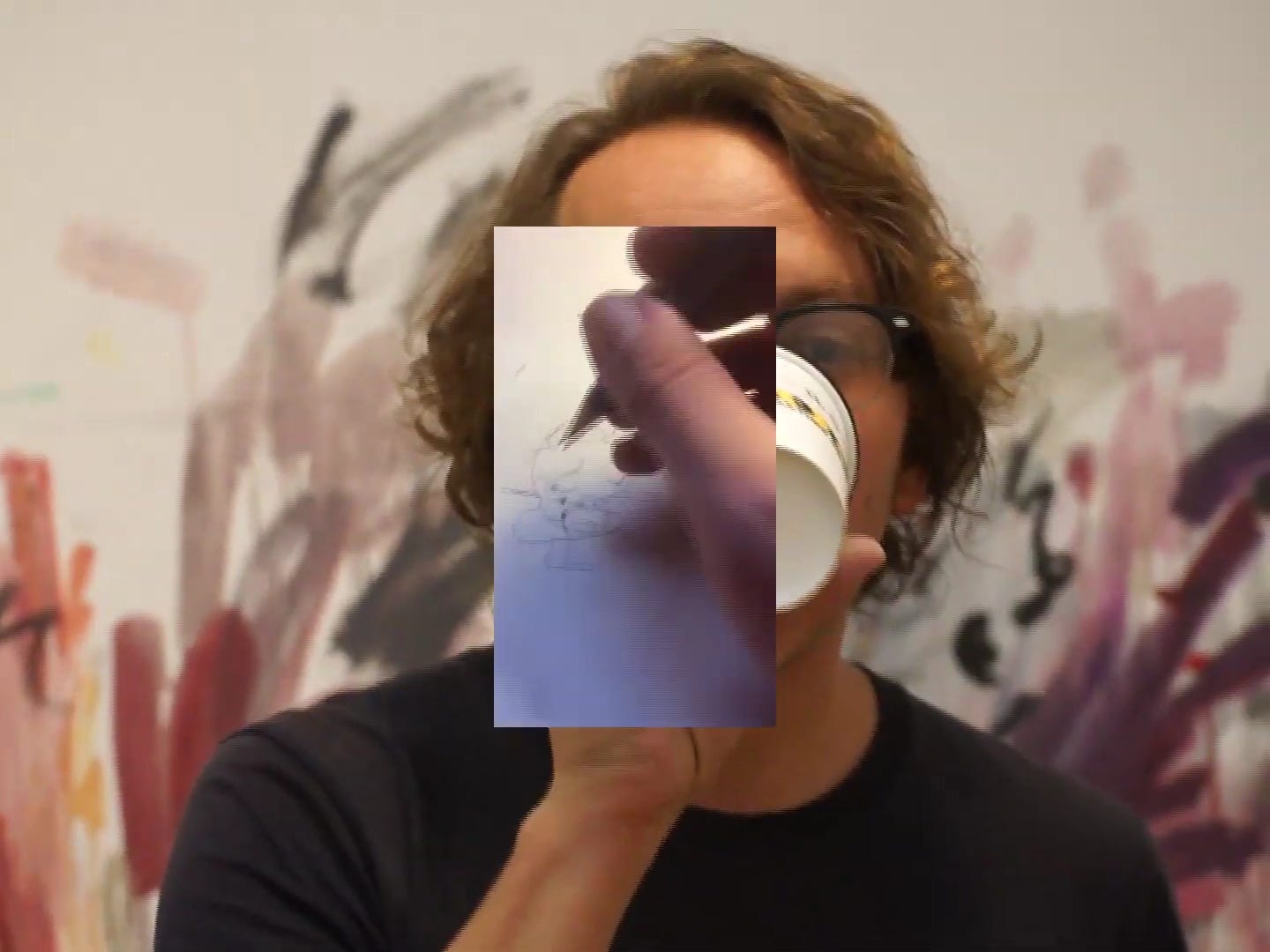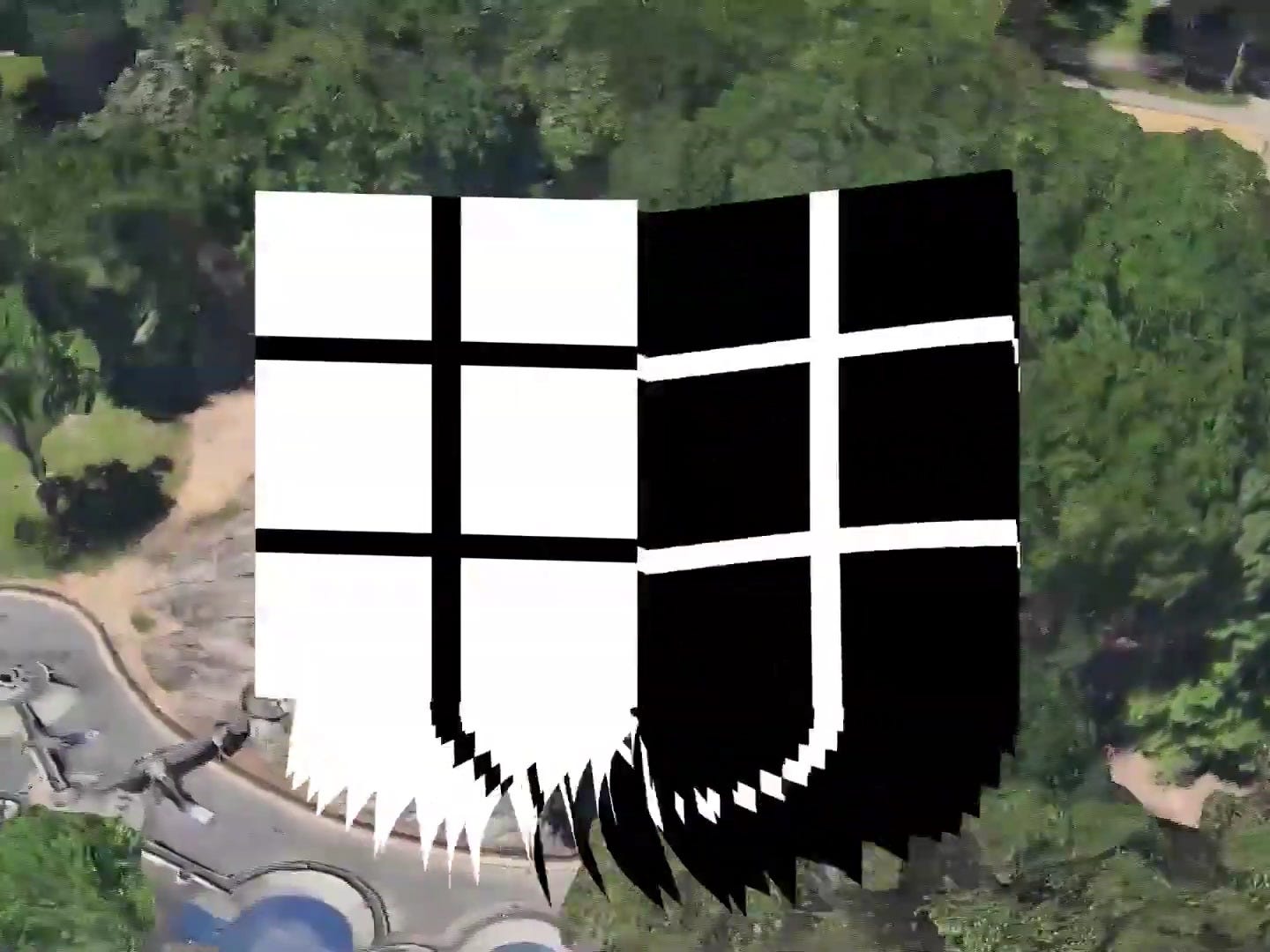This is SIDE A of a piece that was originally published in 2017 on medium. With Aidan Koch’s new book, ‘The Spiral’, out from New York Review Comics in 2024, it seems like a good time to revisit. In the intervening years Austin English has published ‘Meskin and Umezo’, a new book of his own through Domino Books, which has since sold out. Hoping it will end up back in print somewhere!
Aidan x Austin features Aidan Koch and Austin English talking together and drawing together. The talk spans many subjects centered around personal practice and personal histories. While this is going on, we witness each artist's approach to drawing and collaboration. Each artist begins a drawing and mails it to the other. Each artist receives a drawing and completes it.
Just prior to the talk, each had released a major publication spanning years of work, provoking reflection on their past and present positions and how they got there (‘After Nothing Comes’ by Aidan Koch collects zines from 2008–2014. ‘Gulag Casual’ by Austin English collects stories from 2010–2015).
Aidan Koch: It's beginning…how do we wanna start?
Austin English: Sometimes you're in interviews and someone has this outlandish take on something (AK quietly laughs) and then they kinda force the person being interviewed to respond as if that's correct.
Aidan: yeah.
Austin: I think that happens to every artist you like and then you see the artist politely taking in that interpretation so…maybe it actually leaves you further away from actually understanding that person's work. So I was gonna talk about stuff that I noticed and maybe you could tell me how close I am to being correct.
Aidan: (laughs) cool. yeah… I mean have enough shit that we probably won't get to all of this. Yeah, and I mean I just have little general things…
Austin: I got 'Warmer' from you years ago, in the mail, and I remember reading it in my room which you later subleted. I just remember because, sometimes people's first comic, it's already there, it's like already their voice. And you'd done stuff before but it's like you say in your interview, and it's what i say in the note to the reader in 'Gulag Casual', this is the beginning of the work that relates to work that we both do now.
Aidan: Ya, ya.
Austin: So I was relating 'Warmer' to your current work, and I remember this moment when I first read it and it struck me again when I was rereading it. There's this kinda thrilling passage where you turn the page and one of the characters says "it is so hard though" and that is a really specific emotional phrase, really specific emotional language.
Aidan: (laughing)
Austin: And so in your newer work, in 'Glass Surfaces and Still Pools', there's still clear emotional language. You say, "do you know I'm alive", but the way I react to stuff in Warmer is much clearer and it feels even though Warmer is patched together and it is not a traditional structured story, (AK: yeah) you can, sort of, with less work, you can piece together the emotion of the piece. In the new work, there's more abstraction to the emotion. And so I was wondering if 'Warmer' is more of a reflection maybe of different emotional states you're going through mixed together, like a collage of feeling. Whereas new work kinda has, it's to me more like a puzzle. There's obvious, you have obviously emotional reaction to it, but it's much more like something you have to work with. And I was wondering if that makes sense to you? Are you adding more obstruction to recent work? Or if that's totally off?
AK: (Quietly laughs) I mean, I think it's on in terms of rawness or something. Since that was basically the first step from taking life drawings and zines and things and combining it with other material that I was writing. So lists and like… VERY young and emotive and expressive work. Just putting those things together. (AE: right) and I think I was a more sensitive, pained, human being at the time. (laughs) I was really FEELING a lot. (laughs)
AE: I don't feel like the emotion is necessarily different than the current work. (AK: hmm) It's just more upfront. (AK:hmm. yeah.) Or at least there's some clear continuity between now and then…
AK: I mean more in the construction. I think I'm now just understanding how to make stories, that wasn't necessary understanding I was making a story. (AE: huh) In my mind there was no deconstruction of character, setting, narrative. It was just like this thing (AE: right) that came together. Now I'm more considerate of devices. Part of it is understanding the format so manipulating it more subtly or something (AE: right). I like what you said about a puzzle. Now when I come into a story I have, maybe, themes to touch on or narrative arcs that I'm curious about. And I have these different elements and that it's just putting those together. (AE: right). And as I draw, the drawing influences how that flows (AE: right. In recent work). Yes in the recent work. Whereas in other work, I think it was much more just unconscious.
AE: Right. In the interview with Bill Kartalopoulos in the back of the book, you talk about 'Warmer' and how it starts off. You were still life drawing in cafes but there were other things going on in your life, obviously, and you kind of built it all together. I was wondering, is that something that's remained consistent? Because you look at 'Reflections' and it's like, here's maybe some conversations that you were having, maybe you overheard, (AK:yeah) that meant something to you, here are some landscapes (AK:yeah) that maybe you saw during this time, (AK:yeah) and they're together because while maybe they didn't happen on the same day, they are part of a specific period in your life. (AK:yeah) And so maybe that's a key to entering a lot of your work: these are things you seeing and feeling and they are mixed together because it's happening at the same time. (AK:yeah) Maybe that's constant way you've worked, but also, based on your response, in the more recent work, there's more manipulation. Because you are more controlling of the selections, whereas 'Warmer' is more upfront.
AK: Yeah. Because I think in 'Warmer' too, it's pretty much just me. I'm the character. Those are my exact feelings and mental dialogue. My body in times, my actual clothings, my setting, all of it is so much ME.
AE: But then, who is the other person?
AK: That's just the counter to myself. It's not actually anyone that I knew. Blaise brought up in our panel that his comic about panel discussions, for him, they are the ability to play out his own mental dialogue, but making it interesting by distilling parts into different characters. (AE: Right) That's a lot of times why I only have two or three characters, tops. Because it's giving them each a little something, but having one come more primarily from my own experience or point of view. I guess that's pretty standard but…
AE: Yeah that's something our stories share: not a lot of characters. It's like a play structure.
AK: Totally. For me, After Nothing Comes is interesting to look through because it's basically the same story over and over again. (AE: right) (AK: laughs) Considering it was over five years…
It's examining similar things. Even the concept of 'nothing' comes up multiple times. It comes up in 'Dark' with the looming monster guy. 'After Nothing Comes' kind of examining this emptiness or environment or landscape and mental landscape too, I guess. That's the theme. That's really consistent through most of those stories. What else is in there? (laugh)
AE: One thing I noticed is that some of the early stories, characters are talking about how cold it is. (AK: laughs) And then in 'Glass Surfaces', you talk about (AK: Oh yeah) that too. It's like the approach and the way of rendering everything has changed, but it's still those things. And characters in 'Warmer' and 'Reflections', they are parsing out how to communicate with whoever they are addressing and then in 'Little Angels', we have that again - it's not melodramatic like you need to express these things, it's more like I'm trying to get at this thing, it's not exactly working, but I'm trying to figure out how to express this thing and it's causing some kind of state.
AK: Yeah. I guess what that has in common is addressing ambiguous states and how to approach those. How to examine whether or not something is good or bad for you. Or if it's neither, what does that mean. (AE: right) It's very much about extreme ambiguity. (laughs)
AE: Working at the stuff in Gulag, seeing them all together, I was like, they are all the same theme (AK:laugh), and they are all about these little spaces. I was not conscious at that time that they shared that.. But they are all about someone in the space, (AK: yeah) people entering into that space. (AJ: yeah) But that's not a conscious choice. I assume you don't sit down and think "Oh this is my thing, (AK laughs) characters having trouble communicating and reacting to temperature."
AK: When I read all the stories in Nothing, read them all together, I saw the same things pointed out, with the same words even multiple times. And even certain drawing style. Fragments that do appear over and over. (laughs) I'm still trying to understand the same thing (laughs), but yeah.
For yours, I noticed it first…when I had 'Disgusting Room' in newsprint, what I noticed first was the spatial importance. And seeing everything together, my biggest note about it is how intrusion, personal space, and intensity of social interactions and dynamics, flow and weave in and out. I felt that it was probably influenced by New York, San Francisco, or being in city environments. Even the fact that a landlord is a character. (AE: right) Your being a tenant is so New York feeling. How obvious was that influence to you while you were working?
AE: But it's so weird to me because to actually take those themes that you see and that are clearly there…for me to actually take those themes seriously is not possible for me. (AK: yeah) If someone's like: 'your work is about space and characters intruding'. To me, that sounds insane. (AK: laughs) I can only think of the situations as.. It's like how I try to construct all my stories, I have the idea like: a thriller or I want more slapstick element to it but I have such a low level of craft to pull those things off, that by the third panel, it becomes something else. Then I try to catch up with the original intentions that I had - because I have something mapped out for what was supposed to happen - (AK: okay) but then everything gets so turned around that I end up getting so into rendering the characters in different ways, that the tone of the story becomes something completely different. Sometimes I do want to make the story that have a scary element to it, but not in the element that it's gonna be like deep psychological horror (AK: laughs) but just a thrilling horror element to it. I do wonder a little when working on these things what scares me? I do think, with growing up, moving around…we had to move a lot, we lived in a bunch of different places, we were always evicted. But to me, I never really was in pain over that stuff. I was never like, "ugh I gotta tell this story"
AK: (laughs) "This is my story."
AE: Sure. And then going from moving around in childhood to living in New York where you can never really control your personal space.
AK: Yeah. Beds also seem to play also significant role; characters being in bed. (AE: yeah) And that being that in the city that can be your only point of safety and independence or something. That's when you curl up and cry (laughs) (AE: yeah) and your partner and you just sit there and go, "what are we doing? What is life?" (AK: laughs)
AE: The idea of even that space. When I was first living in the city, I had to share a room with a friend…(AK:laughs)
I guess there's something scary to me…
AK: It's like a violation
AE: Yeah, but for me, "violation" sounds so loaded…
I want to write something sort of thrilling and personal to me, but it's not actually what I'm trying to express. It's…an outline for the expression. But, I don't want to sell out the writing. The phrases and things I have characters say…they're almost the most personal thing in my comics, more personal than the imagery. But I guess my storytelling being so murky and disjointed makes me less self-conscious about revealing that stuff because…it's there, but it's not right out in front. There's so much other stuff happening visually that the personal things I'm saying are part of the density…
AK: This relates to both of us. Part of what also gives the effect of the city, gritty essence, is the actual density of the imagery in your drawing, where it's like there isn't that space to breath. Whereas, everyone who reacts to my work is like "there's so much space, it's so empty." (laughs) (AE laughs) Those things automatically influence what people are getting out of both of our works. Nothing, something, or ambiguity. Because "there is so much space, or I don't know how to interpret this!" In yours, "it's so dense!"
AE: Yeah. the layout of your pages - they do have Pacific Northwest openness (AK laughs). I wouldn't have thought of it unless you'd mentioned it.
AK: Your mental landscape can show how things are connected or looping. I think that does come out in stories.
AE: Yeah.
AK: I'm alone a lot and have been for the last five years, just in random places. I'm in my head constantly. Sometimes I'm the only person around, so it's just me and my head. I definitely feel this emptiness. I was reading journals of mine recently, I'm in these crazy places, but in my journals, I don't talk about these places at all. I rant about how I am feeling (laughs).
AE: So when you are in these places, you don't talk about the space at all, it's more just your internal emotional…
AK: Yeah. It's just this crazy, repetitive, circular, internal monologue. I wanted to see if I had written nice notes about my surroundings or "oh did I describe that church" then it's like (cries) "I'm so sad and lonely and this person still won't talk to me, and I don't know what I'm doing" in million, fifty different cities, those are the only notes (laughs).
AE: That was one thing I was gonna bring up. I think a lot of time people discuss your work as being formalist focused. Sometimes that is the discussion about what the work IS, it ends there. But reading all the work together, it's really apparent that emotion overwhelms formalism, or humanism overwhelms formalism. You don't primarily think of the approach because the narratives, to me, seem more like pockets of specific emotions from story to story. (AK: yeah) So when you're describing the journals where you are ranting about everything that's happening… the work feels not like a rant at all. And it's also not like you're cleaning up. It's not like you're trying to put a positive spin on it at all. There's a sadness that seeps through them, but they also feel more like measured.. more like you are in control of the situation that I wouldn't think of even being close to rant.
AK: Yeah. what I mean is as much as I'm in different environments, those environments aren't necessarily affecting me or the way I think. Which I think is why things are getting more and more spacious. It's not necessarily a specific setting, or it's not people being influenced by a setting. It's other little actions or emotional narrative. Not action narratives.
AE: But there was something in 'Little Angels', I felt like "this feels more like urbane setting"
AK: Yes.
AE: Because someone is coming back and it was the first hint of any location in the work.
AK: Yeah. (Laughs)
AE: It feels like from your home or a home setting.
AK: True. But Little Angels was also commissioned by Greater New York so I had to address New York (laughs).
AE: Is that requirement of Greater New York?
AK: No, but because this wasn't a story that already existed… (AE: right) They didn't say it had to be about New York, but they asked to invoke something about the experience. And for me, this is a place that you can't really separate from your interpersonal relations..
AE: It was two characters actually talking to each other. Whereas in your recent work, there's a little bit less of that.
In the story 'Dark' there's actual abstraction happening with the characters, whereas with more recent work, the abstraction is separated away from the figure drawing. I was wondering how intentional that is? And if it is, why you bring in so much more abstraction in general now. Your stories now sometimes open with a swath of abstraction but when characters show up, it's completely removed…
AK: When Impressions jumped around, it tied in so much with the narrative. The character's identity floated around. I don't know (laughs) Maybe I'm pulling more on the subtlety of body language. Having the clarity gives you smaller motions and expressions, that's doing something. I'm not sure. It's interesting to see story by story. everything just slightly changing. It's always been just a little different every time.
How do you feel about looking back at yours as cohesive? Did you feel things changing?
AE: It totally feels different story to story. I wonder if it looks that different for other people, but for me it definitely feels different. Each time I started a new piece for what ended up becoming this book, I wanted to try working with different tools I hadn't used before. I don't have a set way of drawing in any different medium, so each time I start, something new totally changes the way I make images in general, and seeing them next to each other, I was kinda proud of how five stories fit together.
I think the stories in ‘After Nothing Comes’, it's really strange to have them all together in a way because they are such specific emotional events. With some you get more of a mosaic of a person and other are more a specific kind of undercurrent of feeling. I think what was cool about stuff in ‘Gulag Casual’ being together is they almost differentiate themselves better just by being next to each other. I feel like if you're picking up the stuff one by one, you'd be like “oh, just a bunch of weird stuff from that guy” but together they have, I don't know, I think they look cool together.
AK: I think it looks really cool. I had seen many pieces over so many years, it was harder to distinguish such stylistic differences between stories.
Would you want people to go back and see Christina and Charles or older work? Is that something you feel comfortable having out there? or being considered part of your oeuvre? (laughs)
AE: I think for the two books that have spines, I'm definitely proud of Christina and Charles next to this book. I can't draw like that again, (AK laughs.)
AK: It's so nice
AE: I can't believe I let myself get away with Christina and Charles. To me, now looking at it, that's a pretty weird book, but I definitely didn't see it that way at that time. (AK: yeah) Looking at it now, it feels like something I'd be pretty into if it came out TODAY. It looks weirdly still modern? So, I think the books look good next to each other, two out of left field entries. I do think stuff in Windy Corner Magazine is stabbing around for.. I feel a little weirder about that mid-period between the two books.
AK: What chunk of time is that?
AE: Let's see. It's from.. Christina and Charles is 2005 (AK:wow), I know, right? WCM #1 is 2006. So from 2006 to … 2011. That's five years.
AK: Christina and Charles is so impressive for 2005. In terms of what was around then or now.
AE: I misinterpreted what I thought was normal and exciting for the actual tone of what was acceptable at the time? I was so into … I love the history of comics but I'm always excited by new innovations in what's possible with comics. I embrace both the most traditional and the most out-there. I had read Kramers 4 and I had read all the issues of Raw when I was in high school. But I really liked Tintin (AK: laughs) I also really liked EC comics. But when I was working on Christina and Charles, in comparison to the implications of King Cat or Fort Thunder, I thought the book was pretty tame. Now looking back, it still looks outside of what those comics were doing, but I thought it was a book of the moment.
AK: Fits right in
AE: Yeah. I thought it fit right in or at least wouldn't seem as weird as maybe it was perceived. I do think maybe.. 2005 was a specific time. Maybe things have gotten a little more conservative since then.
AK: Yeah. That can be sad.
AE: I think have gotten a little squarer and larger.. maybe because there are so many people making…
AK: Or things didn't progress as much as they felt like they were right then? It felt like a part of a wave, but that wave just died and became a pool that everybody is just kind of doggy-paddling in (laughs)
AE: I think of that sometimes. When stuff was coming out at that time, I was like "man, yes", the idea of experimental painting and experimental writing and comics coalescing seemed so overdue. I was like "of course!" Now it definitely feels like.. I think even people that were right in the forefront doing it took a step back. But now there seems to be this ground swell again. Gulag Casual and After Nothing Comes seem to be built on the same enthusiasm of that moment.
AK: When ‘The Blonde Woman’ was coming out, I was like, "yeah, this is it, great, things will be a breeze after this", "it will be so easy to publish anything I want" and it's still not. Laughs.
AE: But you (laughs) say that as someone who publishes a lot.
AK: Yeah, but I thought eventually things would just be handed to me, they are getting there now, maybe. But I have been working for a minute now, I have been here. Laughs.
AE: When I finished the stuff in ‘Gulag Casual’, before it was supposed to be a book… you know, everyone who makes comics knows, comics take so much work…
AK: YEAH.
AE: The stuff in ‘Gulag Casual’ was five years worth of work that I do really love. At the end of it, I thought "Well, that was a lot of work." (AK: laughs)
I don't see comics necessarily being… I love it so much but it's also, what a weird place to drop this statement of all these drawings, shapes, color, thoughts phrases..what a weird place to drop all this into. Which feels ego maniacal, (AK laughs) but also you are the person doing it, you're like "well, is this the right place to put all this stuff that I care about into?" So for a couple of years after finishing the stuff in ‘Gulag Casual’, I got excited about having fulfilled my heartfelt obligation to comics, at least in the short term. I felt like I had earned myself a comics vacation, a moment where I could justify to myself making work that wasn't comics that I put as much work into. So I let myself draw and paint images that could just exist on their own, outside of a story or a narrative. And now I feel like I created this cool thing for myself where I'm in safari between comics and drawing stuff that will be in shows (AK: yeah) and I feel like both worlds definitely have their problems, but if you don't have all your time and energy invested in one of the two areas, it just feels like another thing that you're doing. And that's solved a lot of things for me, allowed me up to do even stranger things in both mediums. And I feel like that's where you're at too.
AK: I don't think my energy would sustain if I wasn't also in art.
AE: Is it similar to my thing, the safari between the two?
AK: I think a little bit. I think for me the comics community feels so safe and supportive and even more thoughtful in a lot of ways.
AE: I think it's definitely smarter than it gives its credit for in comparison to the art world.
AK: Yeah. Even just the fact that.. my work has been reviewed since I put out 'Warmer'. People are reading it and writing thoughtful responses. I've never had my art shows really reviewed in a way that's worth mentioning. I don't see that happening in.. for a while. So having the critical response, having the community that's interested in me producing more… I think the art world is so much more passive in terms of like "you are here, oh you are gone ok" whereas comics wants me to be there.
AE: You're never totally… comics is always open to someone going away for awhile and then coming back and doing work. I think that's really beautiful.
AK: Yeah. because they understand that books takes forever to make. No one expects you to put something out every month, or be in a show every month. You don't have to maintain that presence for people that you know exist. But then, financially being in art actually like… (laughs). (AE: yeah. laughs) I guess in like selling two drawings I can make more than any of my books made me. Laughs.
AE: That's part of the appeal to it, obviously. But I think the real satisfying benefit to being in contact with that world is that you open yourself to a lot of thoughtful aesthetic work that's being done that isn't being done at all in comics. And seeing that…going outside of the comfort zone of comics, a world that I understand aesthetically more…it's very educational and enriching to step outside of that. There's a ton of garbage but you already know about the garbage from the cliche joke about the art world. When you force yourself to look at a lot, there's a lot of gems beneath the surface, in the same way that there's beautiful work in comics that the general public doesnt see, because they think of comics as genre.
The thing that always drives me crazy about comics is, I don't feel like the work I do is that visually complicated, but when I read a random blog about my work, it's always - for years, ever since ‘Christina and Charles’, it's like a 11 years now - same like "I'm not even saying I don't like it, but it's so crazy, it's so weird. Is it even comics? I just don't know!' I haven't read a review of your work that explicitly says “oh this is really complicated”, but I do think it's sometimes lightly put in that sphere where just like “this is different stuff. different approach” (AK: yeah) As people who do stuff in both worlds, I think stuff we do is actually pretty conservative in terms of a lot of what's happening in the art world (AK: oh yeah) and I feel like that's a good… it makes me feel less crazy about making my comics work (AK: yeah). Sometimes you see work that, in the comics world, would not be thought as that skilled, but in the art world, if it has just a little sense of doing figuration, people are like "oh wow, this person can really draw!", (AK laughs) and I'm like, “I know.. but what about Lale Westvind! She can really draw!”
But all complaining aside, there's stuff that you see that's beautiful.. there's beautiful visual work being made, and especially if you live in New York, you get to see all the time. I think it naturally enriches you. Being part of something you get to know it better, by hearing about people's work that might be more obscure from peers. I think it's such an education. I think it all adds to the pot of what you are doing.
AK: I think that definitely being in that community and absorbing so much visual information, and being around artists who are pushing their personal limits of what they're creating is really helpful and inspiring. It's really cool.
But I was wondering about how people have responded to your works. I haven't really read many reviews of anything, I assume this is gonna be well circulated, someone will have something to say. (AE: laughs) laughs. What do people say?
AE: About the work in the book when it was originally published? (AK: yeah) It's always not that much, you know? (AK laughs) Any middling reviews are usually like "is this even comics? (AK laughs) is this qualified as comics?" Those are the criticisms that come up the most, and maybe they are really valid! I never even think about it when I'm making the work - it's clearly comics to me.
Comics might drive me crazy enough to take a year away from doing comics and do other stuff, but I do think there's something about comics that is like a magnet to me. If I take time away from doing it, it becomes so alluring.. (AK laughs) I just can't, for better or worse, let go. After stepping away from comics for just a little while I feel this magnetic pull not only to want to start MAKING comics again, but just to read them a ton again and fully sink into exploring cartooning, the history of it…. when I was a little kid, I could read any comic because there was something comforting about it and I feel like that again, coming back after stepping away for a little while. Just the idea of pictures being together on a page (AK laughs) is very potent to me… I don't know why.
But, the stories in this book, when I was doing them, I lived, breathed, dreamed COMICS. And, of course, by the end, I was grossed out by comics. Now I'm excited by them again, it's like I have a clean slate in my feelings towards them. And I also do think that comics is something you get better at as you get older and when I dream about what I really want to do with cartooning…I know it'll take time.
Making art that isn't explicitly connected to comics, I don't see my creative horizons opening up as infinitely because I'm still trying to work out the basics of what I'm trying to do. I feel like with comics, I'm finally getting to some kind of understanding of what I want to achieve.
AK: Yeah. I am in a show now where I just made a giant four page comic for it (laughs). Because literally that's the only way I can figure out showing images. (laughs) (AE: laughs) But it works in a different way. It's totally constructed in a very separate way which is how I had to approach it.
My issue with the wall is always like … it's not an intimate reading experience. It's not conducive to do that. But then also, you are only really seeing the skill, you don't have time to register the nuance of creating a story.
AE: For me it's hard to process the whole impact of work on a wall… It's like when you go see a literary reading or something, it all just washes over me. (AK laughs) Something about comics is, for me, so much about comfort and being able to enter this world, someone's made by themselves, in your own time, they drew the whole thing, and you can enter into it whenever you are ready. I never feel that way when I see art on the walls. I do feel more like - confronted with it. Maybe that's why aggressive art has always done so well (AK laughs) because "here I am! check it out!" But I guess with comics it plays to my strengths as a reader. With art I have to calm myself down and get beyond the sterile environment to have a relationship with the work.
END SIDE A, flip for SIDE B next week.
original video and stills shot by Blaise Larmee with Jake Terrell; transcribed by Kim Jooha, Shawn Starr, Justin Skarhus, and Blaise Larmee in 2017.






